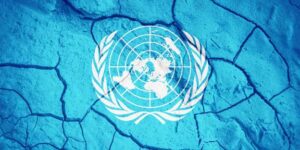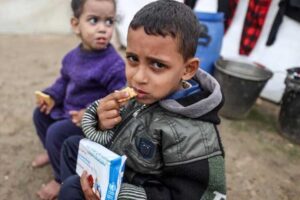
Biodiversity, Combating Desertification and Drought, Conferences, Conservation, COP16, COP29, Editors’ Choice, Environment, Featured, Global, Headlines, Humanitarian Emergencies, Sustainable Development Goals, TerraViva United Nations

David Cooper, Deputy Executive Secretary, Convention on Biological Diversity (CBD), Canadian Environment Minister Steven Guilbeault, Colombian Environment Minister Susana Muhamad and CBD Executive Secretary Astrid Schomaker at a recent press conference in which they looked ahead to COP16. Credit: CBD
– ‘Peace with Nature’ is the theme for the 16th meeting of the Conference of the Parties (COP16) to the Convention on Biological Diversity (CBD), which will take place in Cali, Colombia, between October 21 and November 1, 2024.
But what does ‘Peace with Nature’ mean?
Minister of Environment and Sustainable Development, Susana Muhamad
For COP16 chair and Minister of Environment and Sustainable Development, Susana Muhamad, the theme of Peace with Nature means understanding that climate change and restoring nature are both sides of the same coin.
“That’s the main motivation why Colombia decided to host this conference, we see there is a double movement that humanity has to make,” Muhamad told a press briefing on August 22, 2024.
Her vision clearly places biodiversity as politically relevant as the climate change agenda.
While it is crucial to decarbonize and have a just energy transition, it’s equally important to “restore nature” so that it can, in the end, “stabilize the climate.”
She outlines three political successes: strong engagement from all sectors, positioning biodiversity as a parallel movement to decarbonization, and approving the Digital Sequencing Information Fund.
“At the same time as we are not decarbonizing, the climate will continue changing, and nature will not have the time to adapt,” Muhamad said. “And if nature collapses, communities and people will also collapse, and society will collapse.”
COP16’s role as the first of three COPs (organized respectively by the UNCBD, UNFCCC and UNCCD) this year is to bring “political and economic awareness to biodiversity and so bring humanity back to safe limits during the 21st century.”
CBD Executive Secretary Astrid Schomaker
For CBD’s Executive Secretary Astrid Schomaker, the Columbian presidency’s theme of Peace with Nature is a call to action.
She describes the Kunming-Montreal Global Biodiversity Framework (KMGVF) as the blueprint for making peace with nature, with four goals: protecting and restoring nature, sharing benefits, investing in nature, and collaborating with nature.
Schomaker asserts that COP16 is essential for resolving the outstanding issues from COP 15.
“This is about access and benefit sharing of digital sequence information from genetic resources. Now that’s a very technical subject, but the very, very important one also in terms of the mobilization of resources, but also in terms of the understanding of how we interact with nature, that when we take from nature, we benefit from nature, we give back to nature.”
Schomaker also referred to the need to finance biodiversity with international support, adding to Canada’s donation of USD 200 million. The fund currently stands at USD 300 million.
Finally, COP16 will include initiatives that will bring indigenous peoples and local communities to the table and elevate their voices so that the traditional knowledge they can bring can deepen the debate.
Canadian Environment Minister Steven Guilbeault
Handing over the baton to the COP16 presidency, Guilbeault looked back at COP15, which has been termed biodiversity’s “Paris moment,” referring to the Paris Climate Treaty of 2015, which aims to hold “the increase in the global average temperature to well below 2°C above pre-industrial levels” and pursue efforts “to limit the temperature increase to 1.5°C above pre-industrial levels.”
Despite the achievements and hard work, biodiversity issues are still challenging, and are not yet at “Peace with Nature.”
“Species are still going extinct. We still use natural resources unsustainably. And we’ve still not collectively realized that, in the fight against climate change, our biggest ally is nature.”
What are the challenges?
Finance
Muhamad recognized that financing is crucial for “sustained” and secure resources for the future. She called on Parties to come forward and make firm commitments to finance biodiversity, although they have until 2025 to do so in terms of the Kunming-Montreal Global Biodiversity Framework.
The COP16 chairperson also hoped that this forum would be a “pioneer” for new financing mechanisms that go beyond relying on countries financing the framework and to “open new doors of possibilities for funding mechanisms that are more sustainable and that are at the scale of the challenge that we are facing.”
Business
Muhamad also referred to the proactive role of business with regard to their responsibilities towards keeping a safe environment and its contribution to biodiversity.
The framework mandates government remove, over time, subsidies to sectors of the economy that may impact biodiversity. This could lead to backlash, so human rights and fairness are crucial; however, there are also many opportunities.
“We hope at COP16 to bring a lot of inspiration from those business models that are already incorporated and taking nature as a design into consideration, and that are being the vanguard of new prospects.”
It is also crucial to make this a partnership between government and business to move forward and there will be opportunities in both the green and blue zones at COP16 to take the conversation forward.
Digital sequencing
Muhamad anticipates that the approval of a digital sequencing fund and the mechanism for implementation will be key achievements of the negotiations.
Schomaker added that it had already been “decided that there will be a new global mechanism for sharing the benefits of digital sequencing information on genetic resources, and that global mechanism includes a fund.” What is still under discussion is what form the fund will take.
“Will it be a new fund, a completely new fund, which is one of the options on the table, or will it be one of the existing funds that we have?”
David Cooper, CBD’s Deputy Executive Secretary , agreed that the discussion includes whether to use existing funds like the Global Biodiversity Fund, which is managed by the Global Environment Facility or create a new fund.
IPS UN Bureau Report
















